NASA was well placed to exploit the new administration’s willingness to expand the space program. Its long-term planning was impressive for its detail, in particular
This report was excerpted in the New York Times on 12 January 1961, and is sometimes wrongly dated as such.
because George Low’s committee had costed the accelerated plan – concluding that it would require $7 billion to land a man on the Moon by the end of the decade. In January 1961 Low briefed Keith Glennan on the forthcoming hearings for NASA’s budget, but Glennan expected to be replaced by the new administration and so was in a weak position.
On Johnson becoming Kennedy’s Vice President, Robert S. Kerr took over from him the chairmanship of the Senate Committee on Aeronautical and Space Sciences. After consulting Kerr, Johnson recommended James E. Webb to succeed Glennan as NASA administrator, and Webb took over on 14 February. Whereas Glennan was a scientific administrator with a conservative outlook, Webb was a political operator. He had served as Director of the Bureau of the Budget between 1946 and 1949 and Undersecretary of State from then until 1952 in the Truman administration. He had been a director of Kerr’s oil and uranium conglomerate, Kerr-McGee Oil Industries, and simultaneously a director of the McDonnell Aircraft Company.
Webb immediately set out to obtain the funding that was earlier denied for Apollo and the Saturn launch vehicle. When the Bureau of Budget refused, Webb wrote to Kennedy in early March that Eisenhower had “emasculated the 10-Year Plan before it was one year old’’, and if the funding were not made available it would “guarantee that the Russians will, for the next five to ten years, beat us to every exploratory space flight’’. To ram home the message in terms that Kennedy would appreciate, Webb said, “We have already felt the effects of the fact that they were the first to place a satellite into orbit, have intercepted the Moon, photographed the back side of the Moon, and have sent a large spacecraft to Venus. They can now orbit seven and a half ton vehicles about the Earth, compared to our two and a half tons, and they have successfully recovered animals from flights of as much as 24 hours. Their present position is one from which further substantial accomplishments can be expected, and our best information points to a steadily increasing pace of successful effort on a realistic timetable.’’
On 23 March Kennedy met with Lyndon Johnson, Jerome Wiesner, David Bell of the Bureau of Budget and Edward C. Welsh, a former aide to Johnson who was now serving as Executive Director of the National Aeronautics and Space Council, of which Johnson was chairman. Kennedy agreed to increase funding for the Saturn launch vehicle, but said he would need to deliberate further on the Apollo spacecraft – he would decide in the autumn, he said.
Just when NASA began to think that it might beat the Soviets to a manned space flight, on 12 April 1961 Yuri Alexseyevich Gagarin made a single orbit and landed safely. Webb told Congress, in budget hearings then underway, that NASA could certainly work faster if its funding was increased.
The next evening Kennedy met at the White House with Jerome Wiesner, David Bell, James Webb, Hugh Dryden, Theodore Sorensen, who was a friend and advisor, and Hugh Sidey, a journalist for Life magazine who was one of Kennedy’s friends, and put to them the question, “at what point we can overtake the Russians’’. NASA opened with a space station to be assembled in Earth orbit to serve as a jumping off point for a future mission to the Moon. But, it pointed out, if the Soviets were on the same plan they would likely remain in the lead for some considerable time. Kennedy
|
|
 |
 |
 |
 |
|
|
|
Reds Win Running Lead In Race To Control Space ^ 7:
|
|
|
|
|
The Huntsville Times reports the first man in space.
|
|
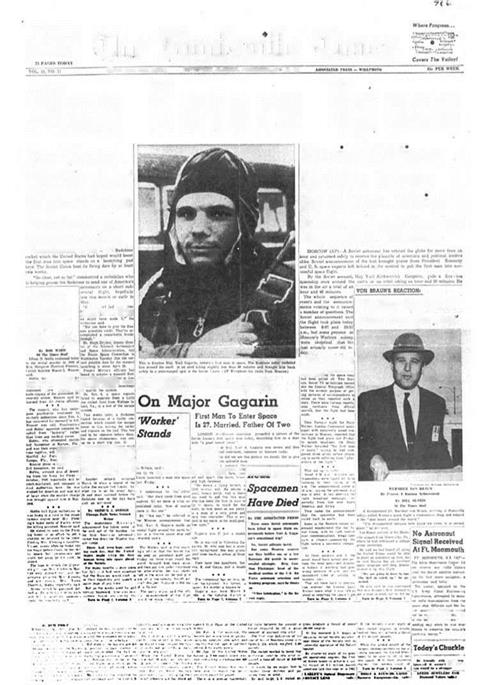
wanted to minimise this period, either by accelerating or by short circuiting the plan. Dryden said a ‘crash’ program might land a man on the Moon ahead of the Soviets, but it might cost as much as $40 billion. ‘‘The cost! That’s what gets me,’’ Kennedy mused. ‘‘When we know more, I can decide if it’s worth it or not. If somebody can just tell me how to catch up.’’ As the meeting broke up, Sorensen remained behind to discuss what had been said, and upon emerging told the others, ‘‘We’re going to the Moon!’’
On 19 April Kennedy summoned Johnson and told him he had decided to issue a momentous challenge. The next day, Kennedy sent a memo to Johnson seeking ‘‘an overall survey of where we stand in space’’. Specifically:
1. Do we have a chance of beating the Soviets by putting a laboratory in space, or by a trip around the moon, or by a rocket to land on the moon, or by a rocket to go to the moon and back with a man. Is there any other space program which promises dramatic results in which we could win?
2. How much additional would it cost?
3. Are we working 24 hours a day on existing programs. If not, why not? If not, will you make recommendations to me as to how work can be speeded up.
4. In building large boosters should we put [our] emphasis on nuclear, chemical or liquid fuel, or a combination of these three?
5. Are we making maximum effort? Are we achieving necessary results?
On 21 April Kennedy told reporters that his administration was considering the options and cost of space, and said, ‘‘If we can get to the Moon before the Russians, we should.’’
Johnson consulted NASA first, which said there was little chance of beating the Russians to a space station; it might be possible to beat them to lunar orbit; the best bet was a lunar landing. This matched Johnson’s thinking. NASA suggested 1967 as a target date because it was expected that the Soviets would attempt to make a lunar landing then in order to mark the 50th anniversary of the Bolshevik Revolution. As a result of the additional analysis by Low, the costing had been increased from the $7 billion estimate for a landing in 1969 to $22 billion; but a landing in 1967 would be $34 billion. Next, Johnson consulted the Pentagon, and the Air Force agreed that a manned lunar landing would be appropriate – even although the Air Force would not be allowed to perform it. Finally, Johnson consulted three businessmen whose judgement he trusted: Frank Stanton of the Columbia Broadcasting System; Donald Cook of the American Electric Power Service Corporation; and George Brown of Brown and Root, which was a construction company in Texas. The fact that none of them was involved in the aerospace industry that would be called upon to build the hardware for the program was a point in their favour, since it meant they were unbiased. At the National Aeronautics and Space Council on 24 April, Johnson, as Wiesner later described it, ‘‘went around the room saying, ‘We’ve got a terribly important decision to make. Shall we put a man on the Moon?’ And everybody said ‘yes’. And he said ‘Thank you’.’’
The scientific community was represented in the White House by Wiesner. The majority of space scientists were interested in particles and fields, and because this
Chairman of the Space Council to be in charge of making an overall survey of where we stand in apace.
1. Do we have a chance of beating the Soviets by putting a laboratory in space, or by a trip around the moon, pr by a rocket to land on the moon, or by a rocket to go to the moon and back with a man. Is there any other space program which promises dramatic results in which we could win?
2. How much additional would it cost?
3. Are we working 24 hours a day on existing programs. If not, why not? If not, will you make reconmenda – tions to me as to how work can be speeded up.
Д. In building large boosters should we put out
emphasis on nuclear, chemical or liquid fuel, or a confcination of these three?
5. Are we making maximum effort? Are we achieving necessary results?

I have asked Jim Webb, Dr. Wiesner, Secretary McNamara
/в/ John F. Kennedy
The historic memo to Lyndon B. Johnson which led John F. Kennedy to challenge his nation to land a man on the Moon before the decade was out.
research did not require a human presence, money spent on sending men into space was by definition wasted. But Kennedy wanted “dramatic results” and the scientists were unable to offer this. To be fair, Kennedy invited Wiesner to suggest a terrestrial challenge that would serve the purpose, “… something with an overseas impact, like desalination or feeding the hungry”. However, Wiesner could see that the Moon was
shaping up to be the challenge, and advised the President “never to refer publicly to the Moon landing as a scientific enterprise”.
On 28 April Johnson submitted the National Aeronautics and Space Council’s recommendation:
Largely due to their concerted efforts and their earlier emphasis upon the development of large rocket engines, the Soviets are ahead of the United States in world prestige attained through impressive technological accomplishments in space. The US has greater resources than the USSR, etc. The country should be realistic and recognize that other nations, regardless of their appreciation of our idealistic values, will tend to align themselves with a country which they believe will be the world leader. The US can, if it will firm up its objectives and employ its resources, have a reasonable chance of attaining world leadership in space. If we don’t make a strong effort now, the time will soon be reached when the margin of control over space and other men’s minds through space accomplishment will have swung so far on the Russian side that we will not be able to catch up. Even in those areas in which the Soviets already have the capability to be first and are likely to improve upon such capability, the United States should make aggressive efforts, as the technological gains as well as the international rewards are essential steps in gaining leadership. Manned exploration of the Moon, for example, is not only an achievement with great national propaganda value, but is essential as an objective, whether or not we are first in its accomplishment – and we may be able to be first.
Kennedy was receptive to Johnson’s recommendation, but he postponed a formal decision until after the first manned Mercury mission, which came on Friday, 5 May 1961 when Al Shepard rode a Redstone missile on a suborbital arc.[19]
Over the weekend, Johnson met James Webb and Secretary of Defense Robert S. McNamara to draw up a formal recommendation to Kennedy’s memo of 20 April. Recommendations for our National Space Program: Changes, Policies and Goals, jointly authored by Webb and McNamara, said, “It is man, not merely machines, in space that captures the imagination of the world. All large-scale projects require the mobilization of resources on a national scale. They require the development and successful application of the most advanced technologies. Dramatic achievements in space, therefore, symbolize the technological power and organizing capacity of a nation. It is for reasons such as these that major achievements in space contribute to

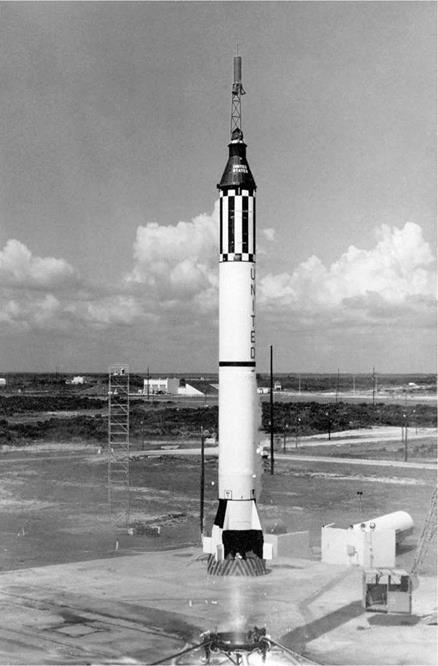
|
On 5 May 1961 a Redstone rocket lifts off with a Mercury capsule containing Alan B. Shepard for a suborbital mission.
|
|
|
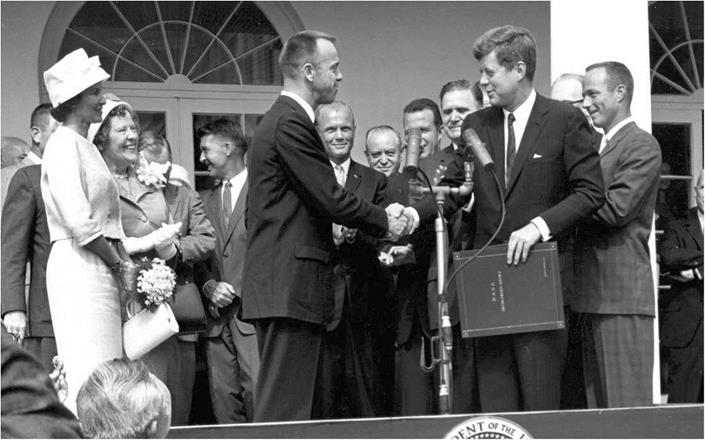
After his successful Mercury flight, Alan B. Shepard shakes hands with John F. Kennedy at the White House.
|
|
 |
In a speech to Congress on 25 May 1961 John F. Kennedy challenged his nation to land a man on the Moon before the decade was out.
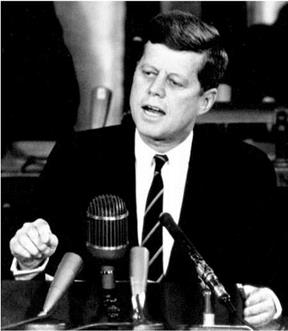 national prestige.” They wrote, “even though the scientific, commercial or military value of [such an] undertaking may by ordinary standards be marginal or economically unjustified”, it nevertheless generated “national prestige”, which had value in its own right. Furthermore, “The non-military, non-commercial, nonscientific but ‘civilian’ projects such as lunar and planetary exploration are, in this sense, part of the battle along the fluid front of the Cold War.’’ This echoed Kennedy’s criticism of Eisenhower: whereas Eisenhower had been conscious of the cost and dismissive of national prestige, to Kennedy national prestige was the issue and the cost was secondary.
national prestige.” They wrote, “even though the scientific, commercial or military value of [such an] undertaking may by ordinary standards be marginal or economically unjustified”, it nevertheless generated “national prestige”, which had value in its own right. Furthermore, “The non-military, non-commercial, nonscientific but ‘civilian’ projects such as lunar and planetary exploration are, in this sense, part of the battle along the fluid front of the Cold War.’’ This echoed Kennedy’s criticism of Eisenhower: whereas Eisenhower had been conscious of the cost and dismissive of national prestige, to Kennedy national prestige was the issue and the cost was secondary.
On 25 May Kennedy gave a speech to a joint session of Congress on the theme of Urgent National Needs. In view of recent space achievements by the Soviets, he proclaimed, ‘‘Now it is time to take longer strides, time for a great new American enterprise, time for this nation to take a clearly leading role in space achievement, which in many ways may hold the key to our future on Earth.’’ Having outlined the political background, he laid down the gauntlet. ‘‘I believe that this nation should commit itself to achieving the goal, before this decade is out, of landing a man on the Moon, and returning him, safely, to the Earth.’’ He had opted for a lunar landing precisely because it posed a great technical challenge. By literally ‘shooting for the Moon’, he was betting that America would not only catch up with the Soviet Union in space, but forge ahead. Having concluded that space was the arena of superpower politics, he was challenging his rival, Nikita Khrushchev, for world leadership. He had imposed the deadline to ensure that reaching the Moon was perceived as a race. He was also well aware of the magnitude of the task. ‘‘No single space project in this
period will be more impressive to mankind, or more important for the long-range exploration of space; and none will be so difficult or expensive to accomplish.” The sending of a man to the Moon was to be the modern form of the ancient practice of ‘single combat’, whereby opposing armies lined up and each dispatched a single warrior to decide the issue. To indicate that it was a matter of national honour, he added, ‘‘In a very real sense, it will not be one man going to the Moon; if we make this judgment affirmatively it will be an entire nation, for all of us must work to put him there.’’ And in order to emphasise what was at stake, he warned, ‘‘If we are to go only halfway, or reduce our sights in the face of difficulty, in my judgment it would be better not to go at all.’’
For Kennedy the Moon was a symbol and, in terms of what he wished to achieve it was an excellent symbol. He had the impression that the applause in Congress was ‘‘something less than enthusiastic”, as he told Sorensen immediately after giving the speech. But Johnson had read the mood well: there was only minor opposition in the House of Representatives, and the debate in the Senate lasted less than an hour – only five of the 96 senators spoke, and the floor was dominated by Robert Kerr, who was Johnson’s man. NASA’s budget was doubled without a formal vote being taken.











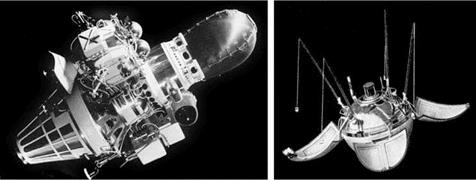
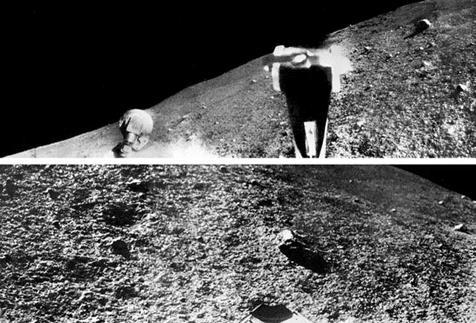
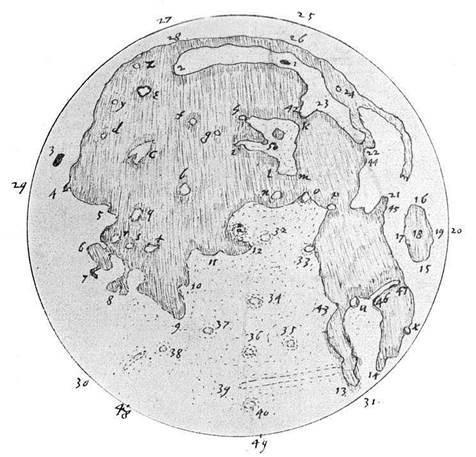
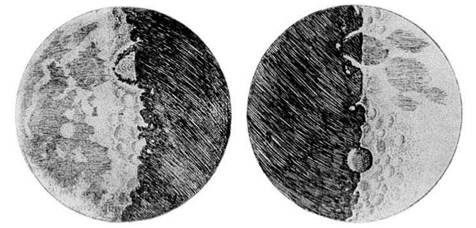
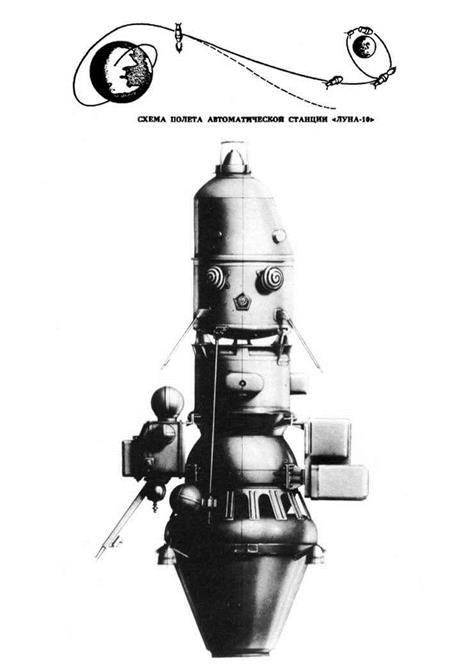
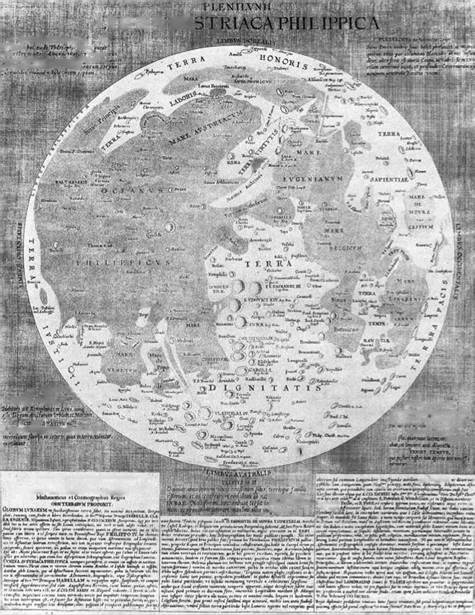 Ш7^ f
Ш7^ f
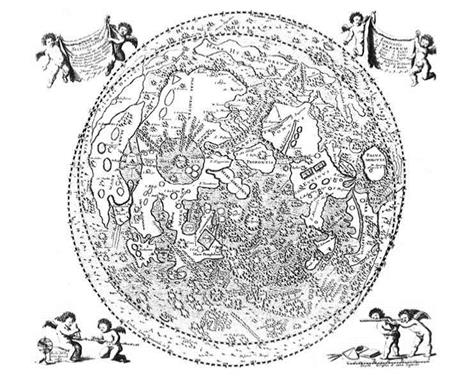
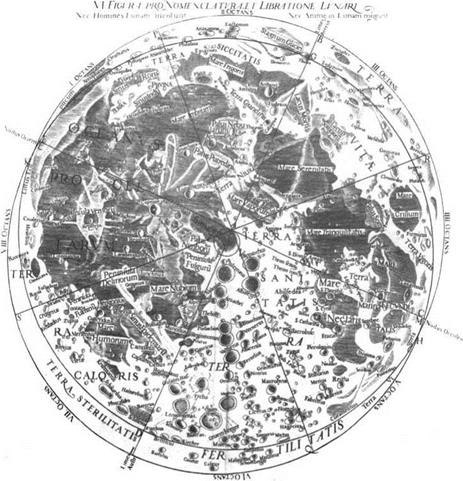
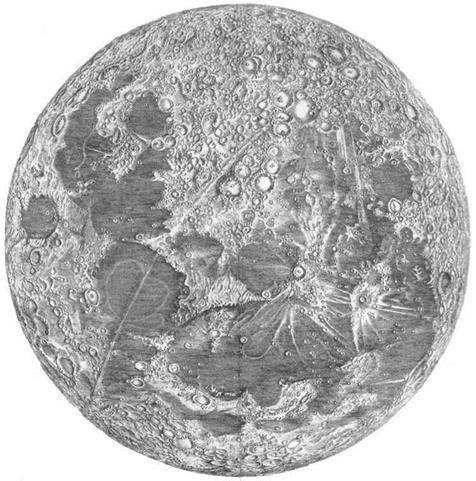
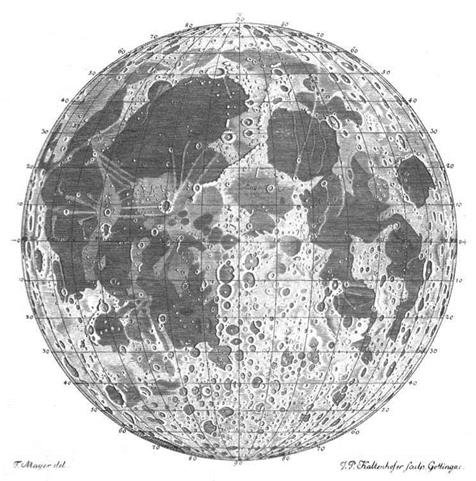




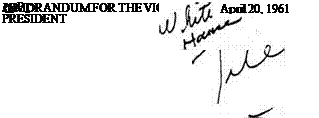


 national prestige.” They wrote, “even though the scientific, commercial or military value of [such an] undertaking may by ordinary standards be marginal or economically unjustified”, it nevertheless generated “national prestige”, which had value in its own right. Furthermore, “The non-military, non-commercial, nonscientific but ‘civilian’ projects such as lunar and planetary exploration are, in this sense, part of the battle along the fluid front of the Cold War.’’ This echoed Kennedy’s criticism of Eisenhower: whereas Eisenhower had been conscious of the cost and dismissive of national prestige, to Kennedy national prestige was the issue and the cost was secondary.
national prestige.” They wrote, “even though the scientific, commercial or military value of [such an] undertaking may by ordinary standards be marginal or economically unjustified”, it nevertheless generated “national prestige”, which had value in its own right. Furthermore, “The non-military, non-commercial, nonscientific but ‘civilian’ projects such as lunar and planetary exploration are, in this sense, part of the battle along the fluid front of the Cold War.’’ This echoed Kennedy’s criticism of Eisenhower: whereas Eisenhower had been conscious of the cost and dismissive of national prestige, to Kennedy national prestige was the issue and the cost was secondary.